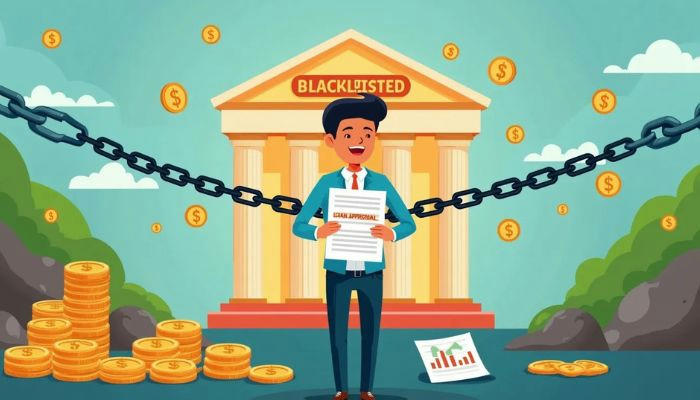Blacklist Loans: The Risky Lifeline You Need to Know
In the world of personal finance, blacklist loans have become a hot topic. These loans are often seen as a last resort for people with poor credit scores or a history of financial missteps. But what exactly are blacklist loans, and why are they both a blessing and a curse? Let’s dive into the good, the bad, and the ugly of this controversial financial product.
What Are Blacklist Loans?
Blacklist loans are designed for individuals who have been "blacklisted" by traditional lenders. Being blacklisted usually means you have a low credit score, a history of late payments, or even a bankruptcy on your record. Traditional banks and credit unions often reject these applicants, leaving them with few options. Enter blacklist loans—specialized loans offered by alternative lenders who are willing to take on the risk of lending to people with bad credit.
These loans can come in various forms, such as:
- Payday loans
- Personal installment loans
- Secured loans (where you put up collateral like your car or home)
The catch? They often come with sky-high interest rates and fees, making them a double-edged sword.

The Good: A Lifeline When You Need It Most
Let’s start with the positives. Blacklist loans can be a lifeline for people who are in desperate need of cash. Life doesn’t always go as planned, and sometimes emergencies happen—like a sudden medical bill, a car breakdown, or an unexpected job loss. When you’re in a tight spot and traditional lenders won’t give you the time of day, blacklist loans can provide the funds you need to get back on your feet.
For many Americans, these loans are the only option when they’re facing eviction, need to keep the lights on, or have to put food on the table. In that sense, blacklist loans can feel like a miracle—a way to survive when the system seems stacked against you.
The Bad: High Costs and Hidden Traps
Now, let’s talk about the downsides. Blacklist loans are notoriously expensive. Interest rates can range from 20% to over 100%, depending on the lender and the type of loan. For comparison, a traditional personal loan might have an interest rate of 5% to 15%. This means that borrowing $1,000 could end up costing you $2,000 or more by the time you pay it back.
And it’s not just the interest rates. Many blacklist loans come with hidden fees, such as:
- Origination fees
- Late payment fees
- Prepayment penalties
These fees can add up quickly, turning what seemed like a quick fix into a long-term financial nightmare.
Worse yet, some lenders use predatory tactics to keep borrowers trapped in a cycle of debt. For example, they might encourage you to roll over your loan, which means taking out a new loan to pay off the old one. This can lead to a never-ending cycle of borrowing and repaying, with the debt growing larger every time.

The Ugly: The Impact on Your Financial Health
The consequences of taking out a blacklist loan can be severe. If you’re already struggling with debt, adding a high-interest loan to the mix can make your financial situation even worse. Missed payments can further damage your credit score, making it even harder to qualify for affordable loans in the future.
In some cases, borrowers have lost their homes or cars because they couldn’t keep up with the payments on a secured blacklist loan. And if you default on an unsecured loan, the lender might take you to court, resulting in wage garnishment or even bankruptcy.
Who Offers Blacklist Loans?
Blacklist loans are typically offered by alternative lenders, including:
- Online lenders
- Payday loan companies
- Some credit unions
These lenders often market their products as "no credit check" or "guaranteed approval" loans, which can be tempting if you’ve been turned down by traditional banks.
However, not all alternative lenders are created equal. Some are reputable and transparent about their terms, while others are outright predatory. It’s crucial to do your research and read the fine print before signing on the dotted line.

Alternatives to Blacklist Loans
Before you resort to a blacklist loan, it’s worth exploring other options. Here are a few alternatives to consider:
Credit Counseling: A credit counselor can help you create a budget, negotiate with creditors, and develop a plan to improve your credit score.
Debt Consolidation Loans: These loans allow you to combine multiple debts into one, often with a lower interest rate.
Borrowing from Friends or Family: While it can be awkward to ask for money, this option is usually interest-free and more flexible than a traditional loan.
Side Hustles: If you need cash quickly, consider picking up a side gig like driving for Uber, delivering groceries, or freelancing online.
Community Assistance Programs: Many communities offer programs to help people in financial distress, such as food banks, utility assistance, and rent relief.
How to Protect Yourself
If you decide that a blacklist loan is your only option, here are some tips to protect yourself:
Shop Around: Compare offers from multiple lenders to find the best terms and rates.
Read the Fine Print: Make sure you understand all the fees, interest rates, and repayment terms before signing anything.
Borrow Only What You Need: It can be tempting to take out a larger loan, but remember that you’ll have to pay it back—with interest.
Have a Repayment Plan: Before taking out the loan, figure out how you’ll repay it. Create a budget and stick to it.
Avoid Rollovers: Rolling over a loan might seem like an easy solution, but it can lead to a cycle of debt that’s hard to escape.
The Bottom Line
Blacklist loans are a risky but sometimes necessary option for people with poor credit. They can provide quick cash in an emergency, but they come with high costs and potential pitfalls. If you’re considering a blacklist loan, weigh the pros and cons carefully and explore all your alternatives first.
Remember, while these loans might solve a short-term problem, they can create long-term financial challenges. The key is to use them wisely and have a solid plan for repayment. After all, the goal is to improve your financial health, not make it worse.

